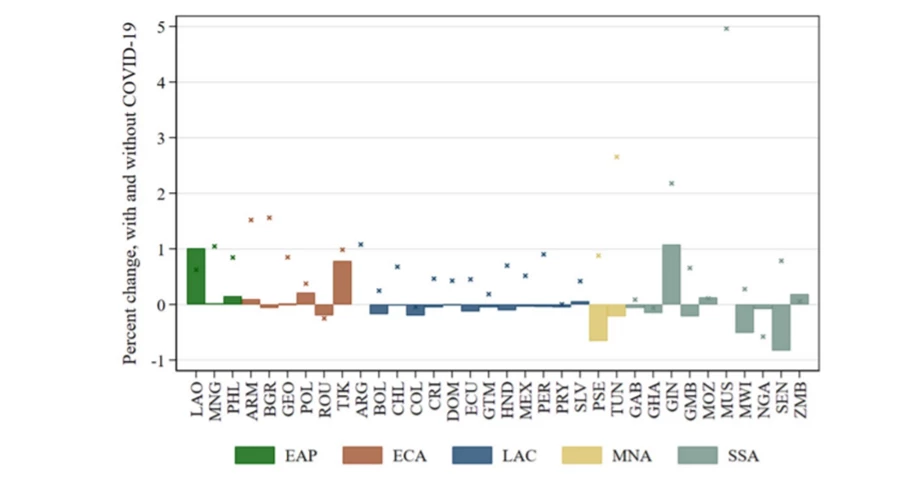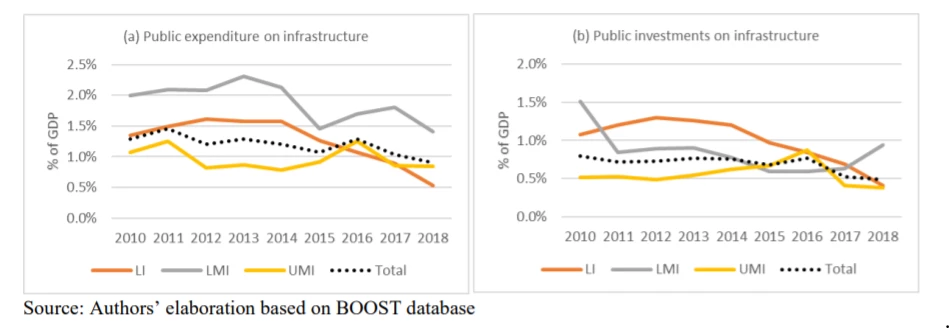 Policy Research Working Paper image
Policy Research Working Paper image
This blog is a biweekly feature highlighting recent working papers from around the World Bank Group that were published in the World Bank’s Policy Research Working Paper Series. This entry introduces four papers published from January 1 to January 15 on various topics, including COVID-19, the US-China trade war and public expenditure on infrastructure.
For the first blog post of 2022, we introduce two papers on topics related to the COVID-19 pandemic. In Challenges of Public Credit Guarantee Schemes in Latin America during the Pandemic, Heinz P. Rudolph and coauthors present the results of a set of surveys covering 19 partial credit guarantees in 12 countries in the Latin America region. In COVID-19 and Economic Inequality : Short-Term Impacts with Long-Term Consequences, Ambar Narayan and coauthors examine the short-term implications of the COVID-19 pandemic for inequality in developing countries.
- Challenges of Public Credit Guarantee Schemes in Latin America during the Pandemic examines partial credit guarantees, a central tool in countries’ strategies to support firms through the COVID-19 pandemic. The paper finds that most partial credit guarantees in the region are not large enough to foster change in the way the local financial sectors conduct business, how they engage with small and medium-size enterprises, and how they assimilate climate and gender considerations. Moreover, the response to the pandemic shows that most partial credit guarantees in the region have made limited use of the toolkit of parametric changes for boosting participation among financial institutions.
- COVID-19 and Economic Inequality : Short-Term Impacts with Long-Term Consequences uses high-frequency phone survey data collected by the World Bank to assess the distributional impacts of the pandemic through the channels of job and income losses, food insecurity, and children’s education in the early days of the pandemic and subsequent period of economic recovery leading up to early 2021. It also introduces a methodology for estimating changes in income inequality due to the pandemic by combining data from phone surveys, pre-pandemic household surveys, and macroeconomic projections of sectoral growth rates. The paper finds that the pandemic had dis-equalizing impacts both across and within countries. The projected income losses are estimated to be higher in the bottom half of the global income distribution. Within countries, disadvantaged groups were more likely to have experienced work and income losses initially and are recovering more slowly. Inequality simulations suggest an increase in the Gini index for 29 of 34 countries in the sample, with an average increase of about 1 percent.
Figure 1: Impact of COVID-19 on income GINI
Note: The bars report the expected percent change in the Gini index from 2019 to 2020 before the COVID-19 pandemic and the dots represent the expected change with the pandemic. Source: Mahler et al.
The last two papers we introduce pertain to the US-China Trade war and public expenditure on infrastructure. In The US-China Trade War and Global Reallocations, Daria Taglioni and coauthors study the global trade responses to the US-China trade war. In Understanding Public Spending Trends for Infrastructure in Developing Countries, Vivien Foster and coauthors provide a relatively disaggregated picture of infrastructure spending trends and patterns for a large sample of more than 70 developing countries covering 2010–18
- The US-China Trade War and Global Reallocations estimates the tariff impacts on product-level exports to the US, China, and rest of world. On average, countries decreased exports to China and increased exports to the US and the rest of world. Most countries export products that complement the US and substitute China, and a subset operate along downward-sloping supplies. Surprisingly, global trade increased in the products targeted by tariffs. Thus, despite ending the trend towards tariff reductions, the trade war did not halt global trade growth.
- Evidence of public expenditure on infrastructure is extremely sparse. Little is known about the trends and patterns of infrastructure expenditure, and there is no real basis for assessing the adequacy and efficiency of infrastructure spending. Understanding Public Spending Trends for Infrastructure in Developing Countries draws on the World Bank’s BOOST database to provide a first relatively disaggregated picture of infrastructure spending trends and patterns for a large sample of more than 70 developing countries covering 2010–18, drilling down into expenditure by sector for roads as well as electricity, and distinguishing operating from capital expenditure. Complementary sources of data are tapped to allow comparison between expenditure patterns on and off budget. The paper finds that on-budget expenditure on infrastructure has been low both in absolute terms (1 percent of gross domestic product) and relative terms (5 percent of total public spending), as well as declining over time. Overall, infrastructure spending declined by about one-third over 2010–18 (with the road sector bearing the brunt of the decrease), and now lies well below estimates of the required levels. There is evidence that low-income countries, despite lower spending envelopes, attach greater priority to public investment and infrastructure spending than their middle-income counterparts. Econometric analysis suggests that infrastructure spending in low- and middle-income countries has been historically procyclical, although to a lesser degree than total expenditure.
Figure 2: Overall government expenditure trends on infrastructure
The following are other interesting papers published in the first half of January. Please make sure to read them as well.
- Infrastructure and Structural Change in the Lake Chad Region (Lebrand,Mathilde Sylvie Maria)
- FDI and Trade Outcomes at the Industry Level—A Data-Driven Approach (Maur,Jean-Christophe,Nedeljkovic,Milan,Von Uexkull,Jan Erik).
- Multidimensionality of Land Ownership among Men and Women in Sub-Saharan Africa (Hasanbasri,Ardina Roosiany,Kilic,Talip,Koolwal,Gayatri B.,Moylan,Heather G.)
- What Explains Boys’ Educational Underachievement in the Kingdom of Saudi Arabia (Elsayed,Mahmoud Abduh Ali,Clerkin,Aidan,Pitsia,Vasiliki,Aljabri,Nayyaf,Al-Harbi,Khaleel)
- The Interplay of Regional and Ethnic Inequalities in Malaysian Poverty Dynamics (Rongen,Gerton,Binti Ali Ahmad,Zainab,Lanjouw,Peter F.,Simler,Kenneth)
- More Is Better : Evaluating the Impact of a Variation in Cash Assistance on the Reintegration Outcomes of Returning Afghan Refugees (Esper,Hisham,Krishnan,Nandini,Wieser,Christina)
- Measuring Quarterly Economic Growth from Outer Space (Beyer,Robert Carl Michael,Hu,Yingyao,Yao,Jiaxiong)





Join the Conversation